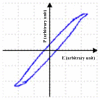Developing an Ear Prosthesis Fabricated in Polyvinylidene Fluoride by a 3D Printer with Sensory Intrinsic Properties of Pressure and Temperature
- PMID: 26959026
- PMCID: PMC4813907
- DOI: 10.3390/s16030332
Developing an Ear Prosthesis Fabricated in Polyvinylidene Fluoride by a 3D Printer with Sensory Intrinsic Properties of Pressure and Temperature
Abstract
An ear prosthesis was designed in 3D computer graphics software and fabricated using a 3D printing process of polyvinylidene fluoride (PVDF) for use as a hearing aid. In addition, the prosthesis response to pressure and temperature was observed. Pyroelectric and piezoelectric properties of this ear prosthesis were investigated using an astable multivibrator circuit, as changes in PVDF permittivity were observed according to variations of pressure and temperature. The results show that this prosthesis is reliable for use under different conditions of pressure (0 Pa to 16,350 Pa) and temperature (2 °C to 90 °C). The experimental results show an almost linear and inversely proportional behavior between the stimuli of pressure and temperature with the frequency response. This 3D-printed ear prosthesis is a promising tool and has a great potentiality in the biomedical engineering field because of its ability to generate an electrical potential proportional to pressure and temperature, and it is the first time that such a device has been processed by the additive manufacturing process (3D printing). More work needs to be carried out to improve the performance, such as electrical stimulation of the nervous system, thereby extending the purpose of a prosthesis to the area of sensory perception.
Keywords: 3D printer; PVDF; pressure; prostheses; smart materials; temperature.
Figures









References
-
- Escoto-Mora G., Gonzalez-Moran C.O., Suaste-Gomez E. Development of poly(vinylidene flouride) polymer applied in force sensors for gait analysis in Wistar mice of physiology research laboratory. Jpn. J. Appl. Phys. 2008;47:4769–71. doi: 10.1143/JJAP.47.4769. - DOI
-
- Gallantree H.R. Review of transducer applications of polyvinylidene fluoride. IEE Proc. I Commun. Speech Vision. 1983;130:219–224. doi: 10.1049/ip-i-1.1983.0040. - DOI
-
- Ueberschlag P. PVDF piezoelectric polymer. Sens. Rev. 2001;21:118–126. doi: 10.1108/02602280110388315. - DOI
Publication types
MeSH terms
Substances
LinkOut - more resources
Full Text Sources
Other Literature Sources

